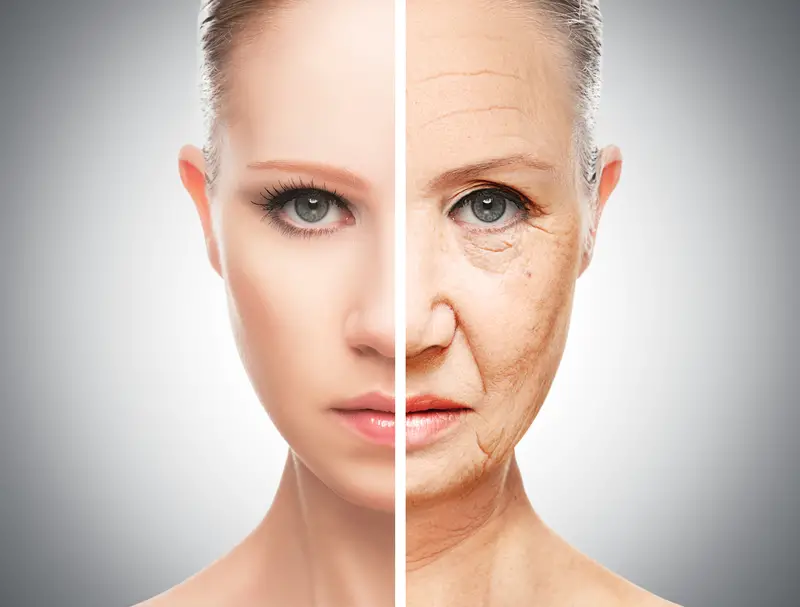That face in the mirror showing new lines every morning might not just be from getting older. Many of the things people do every single day are actually speeding up wrinkle formation without them even knowing it. From how they sleep to what they eat for breakfast, these seemingly harmless daily routines could be adding years to their appearance faster than time itself.
Your phone is creating neck wrinkles
Looking down at phones and tablets for hours creates something dermatologists call “tech neck” – deep horizontal lines across the neck and jawline. Every time someone tilts their head down to check social media or send texts, the skin on their neck folds and creases. After years of this repetitive motion, those temporary folds become permanent wrinkles. The average person checks their phone 96 times per day, which means the neck skin is constantly being compressed and stretched.
The solution isn’t giving up technology completely, but changing how it’s used. Holding devices at eye level prevents the downward head tilt that causes neck creasing. Phone stands and tablet holders make this much easier to maintain throughout the day. Taking regular breaks to stretch the neck and look up also helps prevent the skin from staying in that compressed position for too long.
Sleeping on your side creates face lines
Side sleepers often wake up with pillow marks on their faces, but those temporary lines can become permanent over time. Pressing the face into a pillow for 7-8 hours every night creates repeated pressure and friction on the same spots. The cheek, temple, and eye area get squished against the pillowcase, forming creases that eventually become etched into the skin. People who always sleep on the same side often develop more wrinkles on that particular side of their face.
Switching to back sleeping eliminates face-to-pillow contact entirely, but this isn’t comfortable for everyone. Silk pillowcases reduce friction and allow skin to glide more smoothly across the surface. Some people also find success with specially designed pillows that have cutouts or curves to reduce facial pressure while side sleeping. The key is minimizing how much the face gets compressed during those crucial sleeping hours.
Drinking through straws creates lip wrinkles
The pursed lip motion required for drinking through straws repeatedly contracts the muscles around the mouth. This constant puckering action creates the same type of lines that form around smokers’ mouths, even in people who have never touched a cigarette. Coffee shop visits, smoothie runs, and water bottles with straw lids all contribute to this repetitive muscle movement. The delicate skin around the lips is particularly thin and prone to showing these expression lines.
Drinking directly from cups and glasses eliminates the need for lip pursing entirely. When straws are necessary, using wider ones requires less extreme lip positioning. Wide straws allow for more natural drinking without the intense puckering motion. Being mindful of facial expressions throughout the day helps people catch themselves making repetitive movements that could be contributing to premature line formation around their mouth and lips.
Skipping breakfast accelerates skin aging
Missing the first meal of the day forces the body to break down its own proteins for energy, including the collagen that keeps skin firm and smooth. When blood sugar drops from not eating, the body produces more cortisol, a stress hormone that directly breaks down collagen fibers. This internal process happens every time someone skips breakfast, gradually weakening the skin’s structure from the inside out. The damage accumulates over months and years of irregular eating patterns.
Eating protein-rich foods in the morning provides the building blocks needed for collagen production and repair. Even simple options like Greek yogurt, eggs, or protein smoothies give the body what it needs to maintain healthy skin. The timing matters too – eating within two hours of waking helps stabilize blood sugar and cortisol levels before they spike. Consistent breakfast habits support not just energy levels but also the internal processes that keep skin looking youthful and resilient.
Hot showers are drying out your skin
Those long, steamy showers that feel so relaxing are actually stripping away the skin’s natural protective oils. Hot water breaks down the lipid barrier that normally keeps moisture locked in and irritants out. Without this protection, skin becomes dry, tight, and more prone to developing fine lines and wrinkles. The face is particularly vulnerable because facial skin is thinner and more delicate than body skin, making it even more susceptible to hot water damage.
Lukewarm water maintains cleanliness without destroying the skin’s natural moisture barrier. Limiting shower time to 10 minutes or less also reduces exposure to drying effects. Shower filters can remove harsh chemicals from water that further irritate skin. Applying moisturizer immediately after showering while skin is still damp helps lock in hydration before it evaporates, keeping skin plump and smooth throughout the day.
Squinting at screens damages eye area
Straining to read small text on computers, phones, and tablets causes repeated squinting that creates crow’s feet and forehead lines. The muscles around the eyes contract hundreds of times per day when people struggle to see clearly. This constant muscle tension eventually creates permanent creases in the delicate eye area skin. Many people don’t realize they’re squinting because it becomes such an automatic response to digital eye strain and poor lighting conditions.
Increasing screen brightness and text size reduces the need to squint while reading or browsing. Blue light glasses can reduce eye strain during extended computer use. Taking breaks every 20 minutes to look at something 20 feet away for 20 seconds gives eye muscles a chance to relax. Proper lighting that eliminates glare and shadows also prevents the automatic squinting response that contributes to premature aging around the eyes.
Sugar intake breaks down collagen
When blood sugar spikes from eating sweets, pastries, or refined carbohydrates, it triggers a process called glycation that directly damages collagen and elastin fibers. These proteins normally keep skin firm, smooth, and elastic, but sugar molecules attach to them and create harmful compounds that make skin stiff and prone to wrinkling. The damage happens invisibly inside the body every time blood sugar rises, making it one of the most overlooked causes of premature aging.
Choosing whole grains, fruits, and vegetables instead of processed sweets helps maintain stable blood sugar levels. When sugar cravings hit, options like honey or maple syrup cause less dramatic blood sugar spikes than white sugar. Reading ingredient labels helps identify hidden sugars in foods that might seem healthy but actually contribute to collagen damage. Even small reductions in daily sugar intake can slow down the internal aging process and help preserve skin’s natural firmness and elasticity.
Not getting enough sleep shows immediately
Missing just one night of adequate sleep increases cortisol levels, which breaks down collagen and causes visible puffiness, dark circles, and fine lines. The skin repairs itself during deep sleep phases, producing new collagen and clearing out toxins that accumulate during the day. Without enough sleep, this crucial repair process gets interrupted, leaving skin looking older and more tired. Studies show that people can visually detect sleep deprivation in others’ faces, proving how quickly poor sleep affects appearance.
Getting 7-8 hours of quality sleep each night allows skin to complete its natural repair cycles. Blackout curtains and consistent bedtime routines improve sleep quality and duration. The skin around the eyes is particularly sensitive to sleep loss, so prioritizing rest has immediate visible benefits. Even catching up on missed sleep over weekends helps reduce some of the cumulative damage from weekday sleep deprivation.
Forgetting sunglasses causes eye wrinkles
Bright sunlight forces people to squint even when they’re not consciously aware of it, creating the same repetitive muscle contractions that lead to crow’s feet and forehead wrinkles. UV rays also directly damage the collagen in skin around the eyes, which is already the thinnest and most vulnerable on the entire face. This combination of UV damage plus constant squinting accelerates aging in the eye area faster than almost anywhere else. Even cloudy days expose eyes to significant UV radiation that triggers automatic squinting responses.
Wearing UV protection sunglasses prevents both the sun damage and the squinting that causes expression lines. The glasses need to block 99-100% of UV rays to provide adequate protection. Wraparound styles offer better coverage for the delicate skin around the temples and outer eye area. Making sunglasses as automatic as grabbing keys before leaving the house protects against the daily UV exposure that gradually breaks down skin’s supportive structure.
These everyday habits might seem harmless, but their effects add up over time to create visible aging that could be prevented. Simple changes like adjusting phone height, switching pillowcases, or remembering sunglasses can make a real difference in how skin ages. The best part is that most of these fixes are easy and inexpensive, proving that looking younger doesn’t require expensive treatments or complicated routines.

